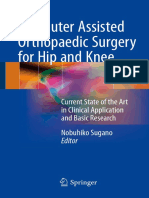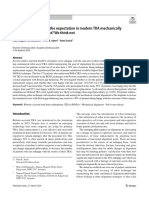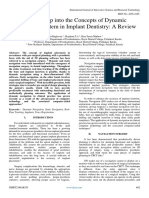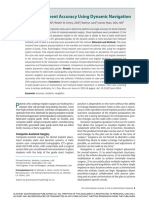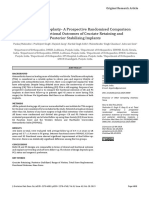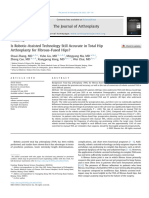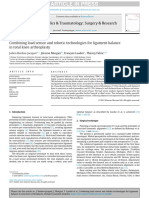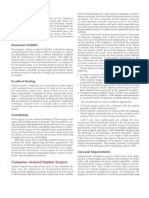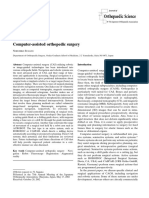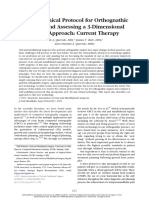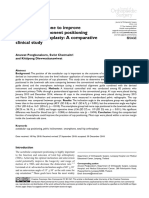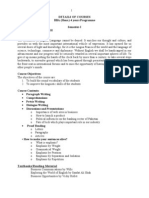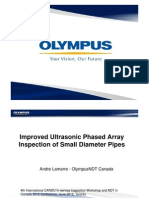Professional Documents
Culture Documents
Implementation of Modern Technologies in Total Knee Replacement
Copyright
Available Formats
Share this document
Did you find this document useful?
Is this content inappropriate?
Report this DocumentCopyright:
Available Formats
Implementation of Modern Technologies in Total Knee Replacement
Copyright:
Available Formats
Volume 8, Issue 5, May – 2023 International Journal of Innovative Science and Research Technology
ISSN No:-2456-2165
Implementation of Modern Technologies in Total
Knee Replacement
Pawan Padam Nath
MBBS, M.S. Orthopaedic, MCh. Orthopaedic (UK), Orthopaedic Surgeon, Consultant Orthopaedic Surgeon,
Rajiv Gandhi University of Health Sciences, Karnataka
Abstract:- Severe osteoarthritis can be effectively treated results. The development of several novel technologies to
with a total knee replacement (TKR), often referred to as increase surgical accuracy has raised hopes for an
an arthroplasty. Even though TKR patients have good improvement in patient contentment following TKR.
survival rates, up to 20% of them are nevertheless
unhappy. Current improvements in knee arthroplasty Aiming to personalise procedure & consider each
technology exhibit promise & may boost functional patient's unique anatomy & ligament balancing,
results. This study sought to present some unique TKR technologies like PSI, CAS, navigation, computer, smart
technologies, their current ideas, merits, & limitations. tools, & positioning accuracy & reliability enhancement, all
Whilst implant placement & limb positioning may be work to enhance implant positioning. But because novel
improved with patient-specific equipment, functional technologies frequently have drawbacks & limits,
results are unchanged. The sensors must attempt to offer understanding how to effectively use them to enhance
accurate data on equilibrium of ligaments during TKR. surgical results is crucial. The objective of this work is to
The accelerometers are sophisticated instruments introduce some recent developments in TKR technology.
created to enhance TKA positioning. However, their
benefits remain still debatable. The robotic-assisted (RA) II. MATERIAL & METHOD
systems provide an exact & repeatable bone preparation
owing to a robotic interface having a 3D surgical The study is conducted using a descriptive
planning, based on preoperative 3D imaging or not. The methodology that relied on secondary data collected through
new technologies in TKA are highly appealing & have case studies & observational studies. The information was
continually progressed. Future orthopaedic technology gathered on cutting-edge technology utilised in field of
will increasingly serve as a beneficial tool for surgeons TKR, including RA arthroplasty, sensors utilised in TKR,
performing patient-specific arthroplasty with patient- accelerometer smart tools & PSI. The following is a
specific positioning goals. discussion of these advance technologies utilised for TKRs.
Keywords:- Knee Arthroplasty; New Technologies; Patient- Patient Specific Instrumentation (PSI):
Specific Instrumentation; Sensors; Accelerometers; RA Several orthopaedic implant manufacturers currently
Surgery. provide PSI systems (Smith & Nephew, Wright Medical
Technology, DePuy, Biomet, Medacta, & Zimmer). Both
I. INTRODUCTION complete & single-compartment knee arthroplasty
procedures can be performed using these systems. To
Orthopaedic surgery, an active medical specialty, has simulate anatomy of knee & create a custom surgical plan
experienced swift & creative improvements in both surgery regarding bone resection, component location, &
& treatment. Recent developments in knee replacement positioning, preoperative 3D imaging (CT scan or MRI) is
technology show promise. TKR, sometimes referred to as performed. Cutting blocks or pin guides are produced &
arthroplasty, is an extremely efficient treatment for serious transported to hospital once surgeon has given his or her
osteoarthritis (Naresh, 2022). Benefits of TKR include a approval, typically in sterile packaging suitable for OR. To
high rate of survival, a prompt resumption to daily activities, position implantation of pins into femur & tibia, pin guides
& a general increase in function, all of which help to meet are positioned on front surfaces of distal femur & proximal
patients’ functional expectations. A significant surgical tibia. With help of these unique cutting guides, bone
objetive is still arthroplasty. Despite advancements in resections can be precisely sliced in accordance with
surgical procedures & after care, up to 20% of TKR patients preoperative 3D planning.
still dislike their outcomes (Noble et al., 2016). Just 64% of
patients in a multicenter cohort of 547 non-selected TKR Sensors in TKR:
patients reported pain-free gait, 35% reported pain-free stair Sensors are utilised to provide unbiased data on soft
climbing or descending, & 40% experienced discomfort tissue balance throughout TKR. These disposable gadgets
when jogging (Bonnin et al.,2020). transmit wireless data to an intra-operative monitor to assist
in making well-informed decisions about implant placement
Since TKR is already a successful procedure, focus is & soft tissue releases to enhance balance & stability
now on raising patient contentment & enhancing functional throughout a wide range of motion. When tibial & femoral
IJISRT23MAY638 www.ijisrt.com 829
Volume 8, Issue 5, May – 2023 International Journal of Innovative Science and Research Technology
ISSN No:-2456-2165
cuts are finished during surgery, system—a wireless, III. RESULT & DISCUSSION
disposable articular loading measurement device—is
inserted in tibial component tray. A few sutures are utilised This section will discuss comparison of advanced
to close capsule. In order to monitor pressures exerted technologies being utilised for TKR to highlight findings
medially and laterally from a fully extended to a fully flexed gathered from earlier studies.
position, surgeon maintains limb in a neutral posture. A
medial & lateral compartment load differential of less than There are studies that have been published that claim
15 pounds is deemed to be sufficiently "balanced". Further that PSI increases implant location accuracy, although
soft tissue releases or bone resection can be done if joint effects of PSI on radiologic outcomes remain unclear
exhibits imbalance following initial ligament balance according to various meta-analyses (Bonnin et al., 2020). De
assessment. et al., (2017) studied postoperative long-leg radiographs
from 155 conventionally conducted TKAs & 569 PSI-
Accelerometer: performed TKAs. With PSI, they found 9% & 22% fewer
Accelerometers are high-tech instruments designed to HKA angle outliers than they did with conventional
facilitate better femoral & tibial component positioning instrumentation.
during TKR. The chance of functional rehabilitation, patient
contentment, & TKR survival may all be increased with Two meta-analyses comparing positioning accuracy
careful component positioning. There is still some debate found no notable variation in outlier numbers for mechanical
over what best positioning is for TKR. The precision of axis, coronal, sagittal, and axial positioning. (Ng et al.,
tibial & femoral cuts is still crucial, regardless of positioning 2015). Nevertheless, a meta-analysis of 6 trials with 444
technique (mechanical, kinematic, limited kinematic). knees by Mannan et al., (2016) found positive femoral
Having a goal positioning that is presently in varus or valgus rotational outcomes. In a randomised controlled experiment
makes an inaccuracy of 3 degrees in element positioning involving 69 patients, Randelli et al.,(2019) found PSI didn’t
very detrimental. Because of need for precise positioning of increase of femoral component rotation’s precision during
each component during surgery, these aids are invaluable. TKA compared to standard instrumentation. No research has
found any differences in clinical or functional results
Robotic-Assisted Knee Arthroplasty: between PSI & traditional techniques.
RA surgery’s widespread use is a logical development
from almost 20-year-old practise of computer-assisted The preoperative planning of PSI, which includes
surgery in knee arthroplasties. Whatever technology is implant sizing, rotation, & femoral & tibial excision, should
employed, major advantage of robotics is precise & theoretically shorten surgery time. However, a newly
repeatable bone preparation made possible by a robotic published meta-analysis by Mannan et al.,(2016) that
interface. This RA technology also enables an evaluation of examined 957 patients discovered a pattern without
ligament balancing in accordance with surgically performed statistical significance of shorter operating times, with 5-
bone cuts & implant placement. The surgeon's valgus or minute average per patient. Comparing length of a surgical
varus stress is typically a factor in this ligament balance. procedure using various modern technologies, such as PSI &
Robotic devices are not intended to take position of CAS, would be intriguing & more pertinent.
surgeons, but rather to enhance their effectiveness. The
robotic arm helps surgeon carry out extremely precise bone The outcomes & effects of sensors on TKR’s ligament
cuts in accordance with surgical plan. Preoperative imaging balancing have been described & evaluated in a number of
study costs, inconvenience to patient in having examination studies. In TKA (for measured resection TKA or modified
done at accredited facilities, & radiation exposure are some gap balancing TKA), Lustig et al., (2016) discovered that an
drawbacks. Image-free RA devices need a manual bone objective measurement employing real-time orthosensor
surface mapping performed intraoperatively. The planning is enhanced soft tissue balance. So, in a potential cohort of 50
then carried out during surgery using a 3D virtual model. No sensor-assisted (SA) TKAs (without substantial deformity),
specific preoperative mapping is done, & 3D imaging is not Scholes et al., (2016) reported that 74% of knees needed
required. Because human mistake is possible, intraoperative further rebalancing with sensor following traditional gap
registration depends on surgeon's accuracy in entering balancing using tensiometer. Evaluation with sensor
relevant data points. Robotic systems for knee arthroplasty revealed coronal and sagittal load imbalances even when a
fall into three categories: passive, semiautonomous, & proper gap balance was attained using a tensiometer.
autonomous. A 3D virtual model provided by a passive However, few studies have indicated that functional
system enables precise preoperative planning. The bone outcomes following sensor assisted TKA are better than
preparation system, however, does not exist. Safeguards are those following conventional TKA, & there are frequently
built into autonomous & semiautonomous systems to several limitations. Without a prior radiographic evaluation,
prevent bone from being removed outside of 3D plan. Lustig et al.,(2016) found that clinical ratings & ROM were
notably greater following SA TKA in comparison with post
manually balanced TKA. In a comparison investigation of
50 SA TKAs, Scholes et al., (2016) found no clinical or
radiological differences between two types of TKAs. To
evaluate clinical value of this gadget, clinical follow-up is
still insufficient.
IJISRT23MAY638 www.ijisrt.com 830
Volume 8, Issue 5, May – 2023 International Journal of Innovative Science and Research Technology
ISSN No:-2456-2165
Accelerometer-based navigation was preferred by the basis of preoperative 3D imaging. As an outcome,
Jiang et al., (2015) for restoration of Hip-Knee-Ankle incorporation of these technologies into TKR has shown to
(HKA), although other research reported no differences be a promising aspect of equipment in future.
between study groups (Ng et al., 2012). At short-term
follow-up, there was no discernible difference between IV. CONCLUSION
functional knee score of iASSIST group (To aid in the
placement of orthopaedic implants, iASSIST Knee System In conclusion promising novel technologies that
is utilised, which is a computer-assisted stereotaxic surgical potentially enhance functional outcomes of TKR have
tool system.) & traditional group (Abdel et al., 2018). recently been discovered. Therefore, while technologies like
According to Scholes et al., (2016) study, using as patient-specific instrumentation can improve implant
accelerometer-based navigation did not result in longer location & limb positioning, functional outcomes are
operating times when compared to traditional methods. unaffected. The customised knee implants aim to function
There hasn't been any analysis of learning curve in literature, similarly to natural knee. The sensors should make every
as it is merely a tool, but not a full navigation system. The effort to provide reliable information on ligament stability
rate of complications with each surgery was found to be during TKA. Accelerometers - ingenious tools utilised to
equivalent. enhance TKA positioning. Their aids haven’t been settled
upon. Accurate & reproducible bone preparation is made
RA systems with image-based & image-free possible by RA systems thanks to a robotic interface & 3D
capabilities have dramatically improved outcomes, surgical planning, which may or may not be based on
particularly about implant location. The level of joint line preoperative 3D imaging. The latest innovations in TKA are
was extremely successfully regulated utilising a robotic incredibly alluring & are always changing. All technologies,
system (RS), as demonstrated by (Randelli et al.,2019). however, need to be critically examined over a long period.
According to research, RA Unicompartmental Knee Predictive modelling & artificial intelligence have ability to
Arthroplasty (UKA) does not necessarily result in a lessen downsides of emerging technologies.
significant improvement in mean implant location. Yet,
decrease in outliers is notable (Naresh, 2022) & hence REFERENCES
pertinent to decline in failure. Similar findings were found
by several meta-analyses & systematic reviews. Moreover, [1]. Noble, P.C.; Conditt, M.A.; Cook, K.F. The John Insall
studies have revealed that a RA system results in superior Award: Patient Expectations Affect Satisfaction with
functional ratings, lower post-operative discomfort, quicker Total Knee Arthroplasty. Clin. Orthop. Relat. Res.
return to work & activity, & improved ligament balancing 2016, 452, 35–43. [CrossRef] [PubMed]
(Noble et al.,2016). [2]. Bonnin, M.P.; Laurent, J.R.; Parratte, S, A. Can
patients really do sport after TKA? Knee Surg.Sports
Research on RA have found that short- & medium- Traumatol. Arthrosc. 2020, 18, 853–862. [CrossRef]
term survival rates are satisfactory. Yet, no comparative [PubMed]
study has shown that RA Unicompartmental Knee [3]. De Vloo, R.; Pellikaan, P.; Dhollander, A.; Sloten, J.V.
Arthroplasty (UKA) has a higher survival rate than Three-dimensional analysis of accuracy of component
traditional UKA. At midterm, published revision rates positioning in total knee arthroplasty with patient
following RA UKA range from 3% to 10%. (Vundelinckx et specific & conventional instruments: A randomized
al., 2016). According to (Noble et al., 2016), image-based controlled trial. Knee 2017, 24, 1469–1477. [CrossRef]
RS increased, in comparison to a conventional technique, [PubMed]
precision of femoral sagittal & coronal positioning, tibial [4]. Ng, V.Y.; De Claire, J.H.; Berend, K.R.;., Jr. Improved
sagittal & coronal positioning, tibial slope & limb Accuracy of AlignmentWith Patient-specific
positioning, & joint line restoration. RA TKA & traditional Positioning Guides Compared With Manual
TKA did not significantly differ in rate of early Instrumentation in TKA. Clin. Orthop. Relat. Res.
complications (Vundelinckx et al., 2016). 2018, 470, 99–107. [CrossRef] [PubMed]
[5]. Jiang, J.; Kang, X.; Lin, Q. Accuracy of Patient-
According to Ajay et al. (2015), image-based RA TKA Specific Instrumentation ComparedWith Conventional
results in less damage to periarticular soft tissues & bone Instrumentation in Total Knee Arthroplasty.
than traditional TKA. For semiautonomous RA system, Orthopedics 2015, 38, e305–e313. [CrossRef]
additional research over long & medium terms is required. [PubMed]
The cutting-edge medical innovations, particularly robotic [6]. Mannan, A.; Smith, T. Favourable rotational
surgery, are also highly intriguing instruments for positioning outcomes in PSI knee arthroplasty: A Level
contentious issue of limb positioning. As a consequence, this 1 systematic review & meta-analysis. Knee 2016, 23,
study summarizes discussed technologies, which include 186–190. [CrossRef] [PubMed]
patient-specific instrumentation that improves implant [7]. Randelli, P.S.; Menon, A.; Pasqualotto, S.; Zanini, B.;
placement & limb positioning but not functional outcomes, Compagnoni, R.; Cucchi, D. Patient-Specific
TKA sensors that must provide objective ligament balance Instrumentation Does Not Affect Rotational Alignment
data, smart accelerometers that improve TKA positioning, & of Femoral Component & Perioperative Blood Loss in
RA systems that, due to a robotic interface, provide accurate Total Knee Arthroplasty: A Prospective, Randomized,
& reproducible bone preparation & 3D surgical planning on
IJISRT23MAY638 www.ijisrt.com 831
Volume 8, Issue 5, May – 2023 International Journal of Innovative Science and Research Technology
ISSN No:-2456-2165
Controlled Trial. J. Arthroplast. 2019, 34, 1374–
1381.e1371. [CrossRef]
[8]. Lustig, S.; Scholes, C.; Oussedik, S.I.; Kinzel, V.;.
Unsatisfactory Accuracy as Determined by Computer
Navigation of VISIONAIRE Patient-Specific
Instrumentation for Total Knee Arthroplasty. J.
Arthroplast. 2016, 28, 469–473. [CrossRef]
[9]. Scholes, C.; Sahni, V.; Lustig, S.;. Patient-specific
instrumentation for total knee arthroplasty does not
match pre-operative plan as assessed by intra-operative
computer-assisted navigation. Knee Surg. Sports
Traumatol. Arthrosc. 2016, 22, 660–665. [CrossRef]
[10]. Abdel, M.P.; Parratte, S.; Blanc, G. No Benefit of
Patient-specific Instrumentation in TKA on Functional
& Gait Outcomes: A Randomized Clinical Trial. Clin.
Orthop. Relat. Res. 2018, 472, 2468–2476. [CrossRef]
[11]. Vundelinckx, B.J.; Bruckers, L.; De Mulder,.
Functional & Radiographic Short-Term Outcome
Evaluation of Visionaire System, a Patient-Matched
Instrumentation System for Total Knee Arthroplasty. J.
Arthroplast. 2013, 28, 964–970. [CrossRef] [PubMed]
[12]. Ajay A. Reverse Sural Fascio Cutaneous Flap for Soft
Tissue Coverage around Foot & Ankle. International
Journal of Innovative Science & Research Technology,
2015, ISSN: 2456-2165,, 4(2), 1018-1021.
[13]. Naresh, G. Implant Removal Surgeries in
Orthopaedics: A Prospective Study. International
Journal of Innovative Science & Research Technology,
ISSN: 2456-2165,2022, 11(5), 982-989.
IJISRT23MAY638 www.ijisrt.com 832
You might also like
- The Surgery-First Orthognathic Approach: With discussion of occlusal plane-altering orthognathic surgeryFrom EverandThe Surgery-First Orthognathic Approach: With discussion of occlusal plane-altering orthognathic surgeryNo ratings yet
- JCM 10 00047Document18 pagesJCM 10 00047Fati EspindolaNo ratings yet
- Technology in ArthroplastyDocument10 pagesTechnology in Arthroplastybá anh ngôNo ratings yet
- Improved Accuracy of Component PositioningDocument9 pagesImproved Accuracy of Component Positioningswastik baratNo ratings yet
- Can Robotic Technology Mitigate The Learning Curve of Total Hip Arthroplasty?Document6 pagesCan Robotic Technology Mitigate The Learning Curve of Total Hip Arthroplasty?PradiNo ratings yet
- 2018 Preoperative CT-Based Three-Dimensional Templating in Robot-Assisted Total Knee Arthroplasty More Accurately Predicts Implant Sizes Than Two-Dimensional TemplatingDocument7 pages2018 Preoperative CT-Based Three-Dimensional Templating in Robot-Assisted Total Knee Arthroplasty More Accurately Predicts Implant Sizes Than Two-Dimensional Templatingsumon.huqNo ratings yet
- Cios 13 1Document9 pagesCios 13 1Sugumar NatarajanNo ratings yet
- AI OrthopaedicsDocument6 pagesAI Orthopaedicsshreyahospital.motinagarNo ratings yet
- Implications of 3-Dimensional Printed Spinal Implants On The Outcomes in Spine SurgeryDocument10 pagesImplications of 3-Dimensional Printed Spinal Implants On The Outcomes in Spine SurgeryOstazNo ratings yet
- Implant Orientation Accuracy of A Hand Held Robotic Partial Knee ReplacemenDocument7 pagesImplant Orientation Accuracy of A Hand Held Robotic Partial Knee ReplacemenSatyaNurAnggaNo ratings yet
- 1 s2.0 S2666638323000701 MainDocument9 pages1 s2.0 S2666638323000701 MainRonald QuezadaNo ratings yet
- Zhang 2020Document6 pagesZhang 2020oscarNo ratings yet
- Next-Generation Robotic Spine Surgery: First Report On Feasibility, Safety, and Learning CurveDocument9 pagesNext-Generation Robotic Spine Surgery: First Report On Feasibility, Safety, and Learning CurvezakyNo ratings yet
- Generating Report of Bone Fracture and Bleeding Using X-Ray ImagesDocument7 pagesGenerating Report of Bone Fracture and Bleeding Using X-Ray ImagesIJRASETPublicationsNo ratings yet
- Total Knee Replacement Modifies The Preoperative Tibial Torsion Angle - Similar Results Between Computer-Assisted and Standard TechniqueDocument9 pagesTotal Knee Replacement Modifies The Preoperative Tibial Torsion Angle - Similar Results Between Computer-Assisted and Standard TechniqueJoko TriwardonoNo ratings yet
- Computer Assisted Orthopaedic Surgery For Hip and Knee 2018 Sugano PDFDocument202 pagesComputer Assisted Orthopaedic Surgery For Hip and Knee 2018 Sugano PDFValdete FigueiredoNo ratings yet
- PT Satisfaction After Robotic KneeDocument6 pagesPT Satisfaction After Robotic KneeMohan DesaiNo ratings yet
- PIIS2352344120300613Document5 pagesPIIS2352344120300613yu prdnyaNo ratings yet
- Implant Placement Accuracy Using Dynamic NavigationDocument9 pagesImplant Placement Accuracy Using Dynamic NavigationMrinmayee ThakurNo ratings yet
- Jomi 5004Document8 pagesJomi 5004Fernando Ari del CorroNo ratings yet
- Navigation in Minimally Invasive Spine Surgery: Sohrab Virk, Sheeraz QureshiDocument6 pagesNavigation in Minimally Invasive Spine Surgery: Sohrab Virk, Sheeraz QureshiliuyonglogNo ratings yet
- KNEE Early Outc Kinematic Retain TKR MCPS Knee 2022 HarveyDocument9 pagesKNEE Early Outc Kinematic Retain TKR MCPS Knee 2022 HarveyPrabhjeet singhNo ratings yet
- Diving Deep Into The Concepts of Dynamic Navigation System in Implant Dentistry A ReviewDocument4 pagesDiving Deep Into The Concepts of Dynamic Navigation System in Implant Dentistry A ReviewInternational Journal of Innovative Science and Research TechnologyNo ratings yet
- Seminario 6. Implant Placement Accuracy Using Dynamic NavigationDocument8 pagesSeminario 6. Implant Placement Accuracy Using Dynamic NavigationLenny GrauNo ratings yet
- Adaptive AI Based Automated Knee Physiotherap - 2021 - Global Transitions ProceDocument8 pagesAdaptive AI Based Automated Knee Physiotherap - 2021 - Global Transitions Procevncheck.comNo ratings yet
- 2017 Laleman - Guided Implant Surgery in The Edentulous Maxilla - A Systematic ReviewDocument15 pages2017 Laleman - Guided Implant Surgery in The Edentulous Maxilla - A Systematic ReviewFabio FabrettiNo ratings yet
- Augmented Virtual and Mixed Reality in Spinal SurgDocument12 pagesAugmented Virtual and Mixed Reality in Spinal SurgSupriya PoudelNo ratings yet
- A Literature Review On Pneumatic Operated CPM Machine For Knee and AnkleDocument5 pagesA Literature Review On Pneumatic Operated CPM Machine For Knee and AnkleIJRASETPublicationsNo ratings yet
- JMC19013 36137Document15 pagesJMC19013 36137Waseem AbbasNo ratings yet
- Robotic Mechanical Alignment Vs Robotic Functional AlignmentDocument10 pagesRobotic Mechanical Alignment Vs Robotic Functional AlignmentMohan DesaiNo ratings yet
- Component Placement Accuracy in Unicompartmental KneeDocument3 pagesComponent Placement Accuracy in Unicompartmental Kneeswastik baratNo ratings yet
- Prabhajith Singh Prava Giri Oct 28 Ori CheckedDocument5 pagesPrabhajith Singh Prava Giri Oct 28 Ori CheckedPrabhjeet SinghNo ratings yet
- Pi Is 0883540322007379Document6 pagesPi Is 0883540322007379Debangshu KumarNo ratings yet
- Accuracy of Computer-Aided Template-Guided Oral Implant Placement A Prospective Clinical StudyDocument10 pagesAccuracy of Computer-Aided Template-Guided Oral Implant Placement A Prospective Clinical StudyMário LúcioNo ratings yet
- Jisakos 2017 000146 PDFDocument10 pagesJisakos 2017 000146 PDFemilNo ratings yet
- Combining Load Sensors & Robotic For Lig BalanceDocument6 pagesCombining Load Sensors & Robotic For Lig BalanceMohan DesaiNo ratings yet
- Use of Computer Navigation in Orthopedic OncologyDocument8 pagesUse of Computer Navigation in Orthopedic OncologyFrontiersNo ratings yet
- An Automated Pelvic Bone Geometrical Feature Measurement Utilities On CT ScanningDocument7 pagesAn Automated Pelvic Bone Geometrical Feature Measurement Utilities On CT ScanningInternational Organization of Scientific Research (IOSR)No ratings yet
- Intelligent X-Ray Based Training System For Pedicle Screw Placement in Lumbar VertebraeDocument7 pagesIntelligent X-Ray Based Training System For Pedicle Screw Placement in Lumbar VertebraeCatalina Sorina ParfeneNo ratings yet
- Ultrasound Machine Research PaperDocument5 pagesUltrasound Machine Research Paperpukytij0wyg3100% (1)
- Carranzas Clinical Periodontology 2nd Southeast Asian Edition PDF Free 10Document78 pagesCarranzas Clinical Periodontology 2nd Southeast Asian Edition PDF Free 10SHUBHAM MALVIYANo ratings yet
- Robotic Alignment of KneeDocument8 pagesRobotic Alignment of KneeMohan DesaiNo ratings yet
- Robotic Assistance For Ultrasound Guided Prostate BrachytherapyDocument9 pagesRobotic Assistance For Ultrasound Guided Prostate Brachytherapykk_kamalakkannanNo ratings yet
- 2018 Selflearningcomputers LafageDocument7 pages2018 Selflearningcomputers LafageShweta ShirsatNo ratings yet
- The Accuracy of Digital Templating in Uncemented Total Hip ArthroplastyDocument6 pagesThe Accuracy of Digital Templating in Uncemented Total Hip Arthroplastyson leNo ratings yet
- X GuideNavigationModelAccuracyJOI10.16Document7 pagesX GuideNavigationModelAccuracyJOI10.16Mrinmayee ThakurNo ratings yet
- 1 s2.0 S1010518223000938 MainDocument8 pages1 s2.0 S1010518223000938 MainESTEFANIA MATTOS MARINNo ratings yet
- Arthroplasty TodayDocument8 pagesArthroplasty TodaySanty OktavianiNo ratings yet
- 21 Computer Assited Orthopedic Surgery 2003Document7 pages21 Computer Assited Orthopedic Surgery 2003SuzanaPetrovicNo ratings yet
- Retrospective Analysis of Functional Outcome of Total Knee Replacement in Rural Teaching SetupDocument5 pagesRetrospective Analysis of Functional Outcome of Total Knee Replacement in Rural Teaching SetupIJAR JOURNALNo ratings yet
- Major SynopsisDocument6 pagesMajor Synopsisaman lakraNo ratings yet
- Using A Clinical Protocol For Orthognathic Surgery and Assessing A 3-Dimensional Virtual ApproachDocument15 pagesUsing A Clinical Protocol For Orthognathic Surgery and Assessing A 3-Dimensional Virtual ApproachKorkmaz SayınsuNo ratings yet
- Hospital Future Augmented - Reality - in - SurgeryDocument10 pagesHospital Future Augmented - Reality - in - Surgeryroupen sulahianNo ratings yet
- KINOVEA - Reliability of Kinovea® Software and AgreementDocument12 pagesKINOVEA - Reliability of Kinovea® Software and AgreementTiago MarcheseNo ratings yet
- Sicotj 3 16Document10 pagesSicotj 3 16OstazNo ratings yet
- ABS 21684 LondheDocument13 pagesABS 21684 LondheMohan DesaiNo ratings yet
- Use of Smartphone To Improve Acetabular Component Positioning in Total Hip Athroplasty: A Comparative Clinical StudyDocument8 pagesUse of Smartphone To Improve Acetabular Component Positioning in Total Hip Athroplasty: A Comparative Clinical StudyResidentes TyONo ratings yet
- Medical Engineering and Physics: A. Collo, S. Almouahed, P. Poignet, C. Hamitouche, E. StindelDocument7 pagesMedical Engineering and Physics: A. Collo, S. Almouahed, P. Poignet, C. Hamitouche, E. StindelLuís CamposNo ratings yet
- Wearable Movement Sensors For Rehabilitation A Focused Reviewof Technological and Clinical AdvancesDocument13 pagesWearable Movement Sensors For Rehabilitation A Focused Reviewof Technological and Clinical AdvancesJenner FeijoóNo ratings yet
- Biomedicines 12 00705 1Document13 pagesBiomedicines 12 00705 1jamel-shamsNo ratings yet
- Application of Game Theory in Solving Urban Water Challenges in Ibadan-North Local Government Area, Oyo State, NigeriaDocument9 pagesApplication of Game Theory in Solving Urban Water Challenges in Ibadan-North Local Government Area, Oyo State, NigeriaInternational Journal of Innovative Science and Research TechnologyNo ratings yet
- Exploring the Post-Annealing Influence on Stannous Oxide Thin Films via Chemical Bath Deposition Technique: Unveiling Structural, Optical, and Electrical DynamicsDocument7 pagesExploring the Post-Annealing Influence on Stannous Oxide Thin Films via Chemical Bath Deposition Technique: Unveiling Structural, Optical, and Electrical DynamicsInternational Journal of Innovative Science and Research TechnologyNo ratings yet
- Osho Dynamic Meditation; Improved Stress Reduction in Farmer Determine by using Serum Cortisol and EEG (A Qualitative Study Review)Document8 pagesOsho Dynamic Meditation; Improved Stress Reduction in Farmer Determine by using Serum Cortisol and EEG (A Qualitative Study Review)International Journal of Innovative Science and Research TechnologyNo ratings yet
- Detection of Phishing WebsitesDocument6 pagesDetection of Phishing WebsitesInternational Journal of Innovative Science and Research TechnologyNo ratings yet
- A Study to Assess the Knowledge Regarding Teratogens Among the Husbands of Antenatal Mother Visiting Obstetrics and Gynecology OPD of Sharda Hospital, Greater Noida, UpDocument5 pagesA Study to Assess the Knowledge Regarding Teratogens Among the Husbands of Antenatal Mother Visiting Obstetrics and Gynecology OPD of Sharda Hospital, Greater Noida, UpInternational Journal of Innovative Science and Research TechnologyNo ratings yet
- The Impact of Music on Orchid plants Growth in Polyhouse EnvironmentsDocument5 pagesThe Impact of Music on Orchid plants Growth in Polyhouse EnvironmentsInternational Journal of Innovative Science and Research Technology100% (1)
- Sustainable Energy Consumption Analysis through Data Driven InsightsDocument16 pagesSustainable Energy Consumption Analysis through Data Driven InsightsInternational Journal of Innovative Science and Research TechnologyNo ratings yet
- Esophageal Melanoma - A Rare NeoplasmDocument3 pagesEsophageal Melanoma - A Rare NeoplasmInternational Journal of Innovative Science and Research TechnologyNo ratings yet
- Vertical Farming System Based on IoTDocument6 pagesVertical Farming System Based on IoTInternational Journal of Innovative Science and Research TechnologyNo ratings yet
- Mandibular Mass Revealing Vesicular Thyroid Carcinoma A Case ReportDocument5 pagesMandibular Mass Revealing Vesicular Thyroid Carcinoma A Case ReportInternational Journal of Innovative Science and Research TechnologyNo ratings yet
- Influence of Principals’ Promotion of Professional Development of Teachers on Learners’ Academic Performance in Kenya Certificate of Secondary Education in Kisii County, KenyaDocument13 pagesInfluence of Principals’ Promotion of Professional Development of Teachers on Learners’ Academic Performance in Kenya Certificate of Secondary Education in Kisii County, KenyaInternational Journal of Innovative Science and Research Technology100% (1)
- Consistent Robust Analytical Approach for Outlier Detection in Multivariate Data using Isolation Forest and Local Outlier FactorDocument5 pagesConsistent Robust Analytical Approach for Outlier Detection in Multivariate Data using Isolation Forest and Local Outlier FactorInternational Journal of Innovative Science and Research TechnologyNo ratings yet
- Realigning Curriculum to Simplify the Challenges of Multi-Graded Teaching in Government Schools of KarnatakaDocument5 pagesRealigning Curriculum to Simplify the Challenges of Multi-Graded Teaching in Government Schools of KarnatakaInternational Journal of Innovative Science and Research TechnologyNo ratings yet
- Review on Childhood Obesity: Discussing Effects of Gestational Age at Birth and Spotting Association of Postterm Birth with Childhood ObesityDocument10 pagesReview on Childhood Obesity: Discussing Effects of Gestational Age at Birth and Spotting Association of Postterm Birth with Childhood ObesityInternational Journal of Innovative Science and Research TechnologyNo ratings yet
- Entrepreneurial Creative Thinking and Venture Performance: Reviewing the Influence of Psychomotor Education on the Profitability of Small and Medium Scale Firms in Port Harcourt MetropolisDocument10 pagesEntrepreneurial Creative Thinking and Venture Performance: Reviewing the Influence of Psychomotor Education on the Profitability of Small and Medium Scale Firms in Port Harcourt MetropolisInternational Journal of Innovative Science and Research TechnologyNo ratings yet
- Designing Cost-Effective SMS based Irrigation System using GSM ModuleDocument8 pagesDesigning Cost-Effective SMS based Irrigation System using GSM ModuleInternational Journal of Innovative Science and Research TechnologyNo ratings yet
- Detection and Counting of Fake Currency & Genuine Currency Using Image ProcessingDocument6 pagesDetection and Counting of Fake Currency & Genuine Currency Using Image ProcessingInternational Journal of Innovative Science and Research Technology100% (9)
- Ambulance Booking SystemDocument7 pagesAmbulance Booking SystemInternational Journal of Innovative Science and Research TechnologyNo ratings yet
- Utilization of Waste Heat Emitted by the KilnDocument2 pagesUtilization of Waste Heat Emitted by the KilnInternational Journal of Innovative Science and Research TechnologyNo ratings yet
- Impact of Stress and Emotional Reactions due to the Covid-19 Pandemic in IndiaDocument6 pagesImpact of Stress and Emotional Reactions due to the Covid-19 Pandemic in IndiaInternational Journal of Innovative Science and Research TechnologyNo ratings yet
- An Overview of Lung CancerDocument6 pagesAn Overview of Lung CancerInternational Journal of Innovative Science and Research TechnologyNo ratings yet
- Digital Finance-Fintech and it’s Impact on Financial Inclusion in IndiaDocument10 pagesDigital Finance-Fintech and it’s Impact on Financial Inclusion in IndiaInternational Journal of Innovative Science and Research TechnologyNo ratings yet
- Auto Tix: Automated Bus Ticket SolutionDocument5 pagesAuto Tix: Automated Bus Ticket SolutionInternational Journal of Innovative Science and Research TechnologyNo ratings yet
- An Efficient Cloud-Powered Bidding MarketplaceDocument5 pagesAn Efficient Cloud-Powered Bidding MarketplaceInternational Journal of Innovative Science and Research TechnologyNo ratings yet
- Effect of Solid Waste Management on Socio-Economic Development of Urban Area: A Case of Kicukiro DistrictDocument13 pagesEffect of Solid Waste Management on Socio-Economic Development of Urban Area: A Case of Kicukiro DistrictInternational Journal of Innovative Science and Research TechnologyNo ratings yet
- Forensic Advantages and Disadvantages of Raman Spectroscopy Methods in Various Banknotes Analysis and The Observed Discordant ResultsDocument12 pagesForensic Advantages and Disadvantages of Raman Spectroscopy Methods in Various Banknotes Analysis and The Observed Discordant ResultsInternational Journal of Innovative Science and Research TechnologyNo ratings yet
- Comparative Evaluation of Action of RISA and Sodium Hypochlorite on the Surface Roughness of Heat Treated Single Files, Hyflex EDM and One Curve- An Atomic Force Microscopic StudyDocument5 pagesComparative Evaluation of Action of RISA and Sodium Hypochlorite on the Surface Roughness of Heat Treated Single Files, Hyflex EDM and One Curve- An Atomic Force Microscopic StudyInternational Journal of Innovative Science and Research TechnologyNo ratings yet
- Examining the Benefits and Drawbacks of the Sand Dam Construction in Cadadley RiverbedDocument8 pagesExamining the Benefits and Drawbacks of the Sand Dam Construction in Cadadley RiverbedInternational Journal of Innovative Science and Research TechnologyNo ratings yet
- Predictive Analytics for Motorcycle Theft Detection and RecoveryDocument5 pagesPredictive Analytics for Motorcycle Theft Detection and RecoveryInternational Journal of Innovative Science and Research TechnologyNo ratings yet
- Computer Vision Gestures Recognition System Using Centralized Cloud ServerDocument9 pagesComputer Vision Gestures Recognition System Using Centralized Cloud ServerInternational Journal of Innovative Science and Research TechnologyNo ratings yet
- Coursecontents BbaDocument30 pagesCoursecontents BbaSehar Eiman100% (1)
- Specification ASTM D3350 PDFDocument110 pagesSpecification ASTM D3350 PDFraja reyhanNo ratings yet
- SMA 06 IntA 01 TermPaper UnileverDocument11 pagesSMA 06 IntA 01 TermPaper Unileveraidil fikri ikhsanNo ratings yet
- Caiib Abm Case StudiesDocument256 pagesCaiib Abm Case StudiesMrr Singhh100% (1)
- Contact - AnonTex GroupDocument2 pagesContact - AnonTex GroupshoyebNo ratings yet
- The Impact of Big Data On Accounting and AuditingDocument14 pagesThe Impact of Big Data On Accounting and AuditingMhmood Al-saadNo ratings yet
- Dragonslayer Comic Adaptation 1981Document164 pagesDragonslayer Comic Adaptation 1981Werewolf67100% (1)
- TopGearDocument188 pagesTopGearbarborina1No ratings yet
- Christopher Ebert - Between Empires - Brazilian Sugar in The Early Atlantic Economy, 1550-1630 (The Atlantic World) (2008) PDFDocument224 pagesChristopher Ebert - Between Empires - Brazilian Sugar in The Early Atlantic Economy, 1550-1630 (The Atlantic World) (2008) PDFSonia Jaimes100% (2)
- Indore Dental AssoDocument64 pagesIndore Dental AssoGp MishraNo ratings yet
- MULTIPLE CHOICE: (30 Points) - Select The Best Answer by Choosing The Appropriate Letter. Item Nos. 1 To 3 Are Based On The Following InformationDocument2 pagesMULTIPLE CHOICE: (30 Points) - Select The Best Answer by Choosing The Appropriate Letter. Item Nos. 1 To 3 Are Based On The Following InformationAnne Alag100% (1)
- Cobra Scan InspectionDocument58 pagesCobra Scan InspectionMohsin Iam100% (2)
- Art Scholarship Application: For New Art Majors at BIOLA UniversityDocument1 pageArt Scholarship Application: For New Art Majors at BIOLA UniversityKelly RavialNo ratings yet
- #8 3. UST Lecture 8d Component Reliability Programme - FinalDocument74 pages#8 3. UST Lecture 8d Component Reliability Programme - Finaltl xNo ratings yet
- A Use Case For Policy Routing With KVM and Open VswitchDocument4 pagesA Use Case For Policy Routing With KVM and Open VswitchPhoenix Liebe JeffNo ratings yet
- CV - Dzarra Asmal FadhilaDocument1 pageCV - Dzarra Asmal Fadhiladzarra asmal fadhilaNo ratings yet
- Oticon SafariDocument8 pagesOticon SafariWidodo WirawanNo ratings yet
- Summary of Part-1: Mining Industry in IndiaDocument15 pagesSummary of Part-1: Mining Industry in IndiaRachelle A. ReadNo ratings yet
- American Imperialism in The 19TH CenturyDocument5 pagesAmerican Imperialism in The 19TH CenturyAustin TropNo ratings yet
- Foreign Corrupt Practices Act SurveyDocument6 pagesForeign Corrupt Practices Act SurveyMoses MachariaNo ratings yet
- Bite Registration (Inter-Occlusal Records)Document5 pagesBite Registration (Inter-Occlusal Records)Dr-Mohamed TharwatNo ratings yet
- Transforming Office Depot: A Plan For Renewal and ReinvigorationDocument113 pagesTransforming Office Depot: A Plan For Renewal and ReinvigorationAnonymous Feglbx5No ratings yet
- Complications of Laparoscopic Hernia RepairDocument3 pagesComplications of Laparoscopic Hernia RepairKőblős ZsoltNo ratings yet
- Ethical Hacker Career Guide: What's InsideDocument9 pagesEthical Hacker Career Guide: What's InsidekhangvdNo ratings yet
- Case AnalysisDocument15 pagesCase Analysismaggie0802793% (15)
- Ada 307128Document207 pagesAda 307128Sinan YıldızNo ratings yet
- Murphy v. United States, 45 F.3d 520, 1st Cir. (1995)Document7 pagesMurphy v. United States, 45 F.3d 520, 1st Cir. (1995)Scribd Government DocsNo ratings yet
- Reliable Solution For High Pressure Applications: GH466-32 EN856 / R15 6-Spiral HoseDocument2 pagesReliable Solution For High Pressure Applications: GH466-32 EN856 / R15 6-Spiral HoseRama SamyNo ratings yet
- Bella v1Document4 pagesBella v1ug8No ratings yet
- Declaration of XXXXXXXXX.: (Redacted) Location in The United States of AmericaDocument17 pagesDeclaration of XXXXXXXXX.: (Redacted) Location in The United States of AmericaEnwardCZorhanz94% (31)
- The Age of Magical Overthinking: Notes on Modern IrrationalityFrom EverandThe Age of Magical Overthinking: Notes on Modern IrrationalityRating: 4 out of 5 stars4/5 (41)
- Love Life: How to Raise Your Standards, Find Your Person, and Live Happily (No Matter What)From EverandLove Life: How to Raise Your Standards, Find Your Person, and Live Happily (No Matter What)Rating: 3 out of 5 stars3/5 (1)
- Think This, Not That: 12 Mindshifts to Breakthrough Limiting Beliefs and Become Who You Were Born to BeFrom EverandThink This, Not That: 12 Mindshifts to Breakthrough Limiting Beliefs and Become Who You Were Born to BeRating: 2 out of 5 stars2/5 (1)
- Summary: The Psychology of Money: Timeless Lessons on Wealth, Greed, and Happiness by Morgan Housel: Key Takeaways, Summary & Analysis IncludedFrom EverandSummary: The Psychology of Money: Timeless Lessons on Wealth, Greed, and Happiness by Morgan Housel: Key Takeaways, Summary & Analysis IncludedRating: 4.5 out of 5 stars4.5/5 (84)
- ADHD is Awesome: A Guide to (Mostly) Thriving with ADHDFrom EverandADHD is Awesome: A Guide to (Mostly) Thriving with ADHDRating: 5 out of 5 stars5/5 (6)
- The Ritual Effect: From Habit to Ritual, Harness the Surprising Power of Everyday ActionsFrom EverandThe Ritual Effect: From Habit to Ritual, Harness the Surprising Power of Everyday ActionsRating: 4.5 out of 5 stars4.5/5 (7)
- The Twentysomething Treatment: A Revolutionary Remedy for an Uncertain AgeFrom EverandThe Twentysomething Treatment: A Revolutionary Remedy for an Uncertain AgeRating: 5 out of 5 stars5/5 (4)
- By the Time You Read This: The Space between Cheslie's Smile and Mental Illness—Her Story in Her Own WordsFrom EverandBy the Time You Read This: The Space between Cheslie's Smile and Mental Illness—Her Story in Her Own WordsNo ratings yet
- LIT: Life Ignition Tools: Use Nature's Playbook to Energize Your Brain, Spark Ideas, and Ignite ActionFrom EverandLIT: Life Ignition Tools: Use Nature's Playbook to Energize Your Brain, Spark Ideas, and Ignite ActionRating: 4 out of 5 stars4/5 (404)
- Raising Mentally Strong Kids: How to Combine the Power of Neuroscience with Love and Logic to Grow Confident, Kind, Responsible, and Resilient Children and Young AdultsFrom EverandRaising Mentally Strong Kids: How to Combine the Power of Neuroscience with Love and Logic to Grow Confident, Kind, Responsible, and Resilient Children and Young AdultsRating: 5 out of 5 stars5/5 (1)
- I Shouldn't Feel This Way: Name What’s Hard, Tame Your Guilt, and Transform Self-Sabotage into Brave ActionFrom EverandI Shouldn't Feel This Way: Name What’s Hard, Tame Your Guilt, and Transform Self-Sabotage into Brave ActionNo ratings yet
- Manipulation: The Ultimate Guide To Influence People with Persuasion, Mind Control and NLP With Highly Effective Manipulation TechniquesFrom EverandManipulation: The Ultimate Guide To Influence People with Persuasion, Mind Control and NLP With Highly Effective Manipulation TechniquesRating: 4.5 out of 5 stars4.5/5 (1412)
- Summary: Outlive: The Science and Art of Longevity by Peter Attia MD, With Bill Gifford: Key Takeaways, Summary & AnalysisFrom EverandSummary: Outlive: The Science and Art of Longevity by Peter Attia MD, With Bill Gifford: Key Takeaways, Summary & AnalysisRating: 4.5 out of 5 stars4.5/5 (44)
- Dark Psychology & Manipulation: Discover How To Analyze People and Master Human Behaviour Using Emotional Influence Techniques, Body Language Secrets, Covert NLP, Speed Reading, and Hypnosis.From EverandDark Psychology & Manipulation: Discover How To Analyze People and Master Human Behaviour Using Emotional Influence Techniques, Body Language Secrets, Covert NLP, Speed Reading, and Hypnosis.Rating: 4.5 out of 5 stars4.5/5 (110)
- 12 Rules for Life by Jordan B. Peterson - Book Summary: An Antidote to ChaosFrom Everand12 Rules for Life by Jordan B. Peterson - Book Summary: An Antidote to ChaosRating: 4.5 out of 5 stars4.5/5 (207)
- Mindset by Carol S. Dweck - Book Summary: The New Psychology of SuccessFrom EverandMindset by Carol S. Dweck - Book Summary: The New Psychology of SuccessRating: 4.5 out of 5 stars4.5/5 (329)
- Raising Good Humans: A Mindful Guide to Breaking the Cycle of Reactive Parenting and Raising Kind, Confident KidsFrom EverandRaising Good Humans: A Mindful Guide to Breaking the Cycle of Reactive Parenting and Raising Kind, Confident KidsRating: 4.5 out of 5 stars4.5/5 (171)
- The Body Keeps the Score by Bessel Van der Kolk, M.D. - Book Summary: Brain, Mind, and Body in the Healing of TraumaFrom EverandThe Body Keeps the Score by Bessel Van der Kolk, M.D. - Book Summary: Brain, Mind, and Body in the Healing of TraumaRating: 4.5 out of 5 stars4.5/5 (267)
- A Brief History of Time: From the Big Bang to Black HolesFrom EverandA Brief History of Time: From the Big Bang to Black HolesRating: 4 out of 5 stars4/5 (2193)
- The Garden Within: Where the War with Your Emotions Ends and Your Most Powerful Life BeginsFrom EverandThe Garden Within: Where the War with Your Emotions Ends and Your Most Powerful Life BeginsNo ratings yet
- Summary: How to Be an Adult in Relationships: The Five Keys to Mindful Loving by David Richo: Key Takeaways, Summary & Analysis IncludedFrom EverandSummary: How to Be an Adult in Relationships: The Five Keys to Mindful Loving by David Richo: Key Takeaways, Summary & Analysis IncludedRating: 4 out of 5 stars4/5 (11)
- The Fun Habit: How the Pursuit of Joy and Wonder Can Change Your LifeFrom EverandThe Fun Habit: How the Pursuit of Joy and Wonder Can Change Your LifeRating: 4.5 out of 5 stars4.5/5 (19)
- The Secret of the Golden Flower: A Chinese Book Of LifeFrom EverandThe Secret of the Golden Flower: A Chinese Book Of LifeRating: 5 out of 5 stars5/5 (4)















